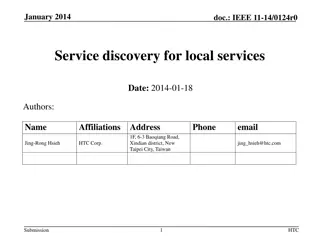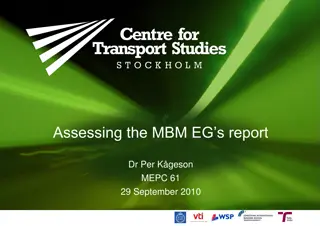Optimizing Cost Reduction Strategies in E-Discovery
Explore strategies for minimizing the expected costs of document review in E-Discovery processes, focusing on the joint considerations of responsiveness and privilege. Various ideas are presented, including population annotation, automated classification, multi-stage manual reviews, and task-based misclassification cost analysis. By understanding and implementing these cost-efficient methods, organizations can enhance their document review processes effectively.
Download Presentation

Please find below an Image/Link to download the presentation.
The content on the website is provided AS IS for your information and personal use only. It may not be sold, licensed, or shared on other websites without obtaining consent from the author.If you encounter any issues during the download, it is possible that the publisher has removed the file from their server.
You are allowed to download the files provided on this website for personal or commercial use, subject to the condition that they are used lawfully. All files are the property of their respective owners.
The content on the website is provided AS IS for your information and personal use only. It may not be sold, licensed, or shared on other websites without obtaining consent from the author.
E N D
Presentation Transcript
Volume 37, Issue 1, Article 11 (November, 2018) Jointly Minimizing the Expected Costs of Jointly Minimizing the Expected Costs of Review for Responsiveness and Privilege Review for Responsiveness and Privilege in E in E- -Discovery Discovery Douglas W. Oard, University of Maryland (USA) oard@umd.edu Fabrizio Sebastiani, CNR (Italy) fabrizio.sebastiani@isti.cnr.it Jyothi K. Vinjumur, Walmart (USA) jyothi.keshavan@gmail.com July 27, 2020 SIGIR TOIS Talk
Document Review for E-Discovery Employ a reasonable process to: Identify documents that are relevant (i.e., responsive ) to a request Among the relevant documents, identify those that are privileged 3 possible actions: Produce (i.e., disclose) documents that are relevant and not privileged Enter on a Privilege Log documents that are relevant and privileged Withhold documents that are not relevant
Idea #1: Idea #1: Finite Population Annotation Automatic Classifier Manual Review Quality . Manual Effort
Idea #1: Idea #1: Finite Population Annotation Semi-Automated Classification Automatic Classifier Manual Review Quality . Manual Effort Berardi, Esuli, Sebastiani: Utility-Theoretic Ranking for Semiautomated Text Classification. ACM TKDD, 2015
Idea #2: Idea #2: Two Manual Review Stages Manual Relevance Review Manual Privilege Review Automatic Classification
Idea #3: Idea #3: Task-Based Misclassification Cost Correct Decision Produce Log Withhold Prediction Produce $600 $5 Log $150 $3 4 Withhold $15 $15
Expected Misclassification Cost Cost Per Mistake Correct Decision Produce Log Withhold Expected Prediction Produce $600 $5 Number of Mistakes Log $150 $3 Correct Decision Withhold $15 $15 Produce Log Withhold Expected Prediction Produce 100 5 Misclassification Cost Log 10 1 Correct Decision Withhold 5 1 Produce Log Withhold Prediction Produce $60,000 $25 Log $1,500 $3 Withhold $75 $15 $61,618
Relevance Review Automatic Classification Privilege Review (Platt scaling) Risk-Sensitive Ranker Risk-Sensitive Ranker ar = $1/doc ap = $5/doc Rank by Expected Reduction in Total Cost
Evaluation Test Collection Reuters RCV1-v2 (news stories) Mod-Apte training-test partition (23K train, 200K test) 120 category pairs 24 categories each represent relevance (3% to 7%) [e.g., M12: Bond Markets] For each, 5 other categories represent privilege (1% to 20%) [e.g., E21: Government Finance] Automatic Classifiers Linear-kernel SVMs for relevance and privilege Standard term weights for this collection (tfidf:ltc, stemmed, stopped) Manual review Simulated as perfect judgments (using ground truth) Evaluation measure Expected Total Cost: manual annotation cost + misclassification cost
Average Improvement Over Baselines Increase in cost over our Risk Minimization Cascade Active Learning Uncertainty Sampling Active Learning Relevance Sampling Fully Fully Manual Uncertainty Ranking Relevance Ranking Lowest Privilege Error Cost Automatic +29% +235% +47% +47% +52% +52% Case 1 $150 (>> $5) +2% +893% +10% +4% +11% +7% $10 (> $5) Case 2 +0% +2,416% +0% +0% +0% +0% Case 3 $1 (< $5) Same amount of manual annotation as Risk Minimization
Concluding Remarks Manual review can improve finite population annotation Cost-sensitive classification benefits from a risk-minimizing review order The risk-minimizing order depends on cost models and error models We have shown results for a 3 linear cost models Two-stage review (relevance, then privilege) requires two review orders Optimal privilege review order benefits from improved relevance estimates Our results rely on two simulations RCV1-v2 news story categories as models for relevance and privilege Perfect ground truth as a model for manual annotation This material is based upon work supported by the U.S. National Science Foundation under Grant Nos. 1065250 and 1618695. Any opinions, findings, and conclusions or recommendations expressed in this material are those of the authors and do not necessarily reflect the views of the National Science Foundation.























